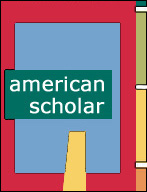English 5571 - American Transcendentalism
Here is the second of three presentations assigned during this course. Each student was to peruse an issue of the Dial (a Transcendentalist literary magazine between 1840 - 44) and give the class a synopsis. The following are the notes I made for the 1844 issue, No. 3. There is no appendix attached to these notes.
1844 Dial, No. 3
1. The Youth of the Poet and the Painter: This is a prose romance written as a group of letters (continued from Letters V - IX in the last No. of the 1843 Dial).
Letter X - from Edward Ashford to James HopeLetter XI - from Edward Ashford to James Hope
Letter XII - from Richard Ashford to Edward Ashford
Letter XIII - from Matthew Gray to James Hope
"It is an attempt to describe the education of a poet, how he was trained for his calling, and how he succeeded in overcoming the educational and social obstacles he found in his way. Evidently the author had not completed his task when "The Dial" came to an end, but his design and his theories are discernible without difficulty. In the seventh letter he gives an account of the way in which transcendentalism influenced the youth of New England, quite of the nature of Emerson's treatment of the same subject; and in the thirteenth he describes the influence of nature upon the poet, and how essential it is to the development of his moral and intellectual character. Here will be found the best of Channing's prose writing, and some of the letters have hardly been surpassed by any of the transcendental writers for delicacy combined with strength, as well for simplicity and directness." (http://www.vcu.edu/engweb/transcendentalism/authors/channing/cooke-channing.html)
2. Translation of Dante: This is a critique of the recent translation of the first ten Cantos of Dante's Inferno by T.W. Parsons (1843). The unidentified critic says of the translation, "Instead of obscurity or vagueness, we find an unexampled clearness, rendered transparent by images that with a single word give the most forcible pictures" (285). There are two examples of Parsons' work in the critique. See Appendix for one of them. In his closing the critic remarks, "On the whole, we feel most grateful to Mr. Parsons for undertaking his work. We think he has done well, but he can do much better" (290). The main argument is that Parsons fails to capture the "whole" of a passage for his attention to particulars. "As it is, we have no little pride, that our city should produce of so much devotion to the highest walks of pure literature" (290).
3. Homer. Ossian. Chaucer.: These are extracts from a lecture on poetry, read before the Concord Lyceum on November 29, 1843 by Thoreau.
4. Lines: A five stanza poem from an unidentified author. An Internet search led me to its author: EMERSON! The fourth stanza seems appropriate for this week since we are discussing slavery. What is the point of freeing slaves if they are not released into something beautiful? (See Appendix).
5. The Modern Drama: A critique of three tragedies.
The Patrician's Daughter, by J. Westland MarstonAthelwold, by W. Smith, Esq.
Strafford, by John Sterling.
6. To R.B.: from C.A.D.
7. Autumn Woods: This is a nature poem (obviously) about "tearful days" and "grief" (350) because of the years of strife. But the woods are a source of hope and delight. "Where nature yearly glorifies her might" (350). The last stanza:
Far through the fading treesThe pine's green plume is waving bright and free,
And in the withered age of man to me
A warm and sweet spring breeze.
8. Brook Farm: by C.L. The first paragraph reads thus, "The Institution at Brook Farm, [. . .], though sufficiently extensive in respect to number of persons, perhaps is not to be considered an experiment of large intent. Its aims are moderate; too humble indeed to satisfy the extreme demands of the age" (351). He/she argues in this piece that Brook Farm is not a community. It is not even an association by its general definition. It is an "aggregation of persons, and lacks that oneness of spirit" that is necessary to make an impact on mankind (354).
9. Tantalus: Tantalus was the mortal son of Zeus. No author specified.
10. The Fatal Passion: This is a dramatic sketch by William Ellery Channing in two Acts.
11. Interior or Hidden Life: This is a look at a book by Thomas C. Upham (taught moral philosophy at Bowdoin College) called Principles of the Interior or Hidden Life (1843). The main thesis is that "the human soul, every human being, may be holy" (373). This is an obvious Emersonian tenet that has permeated the transcendentalist view of mankind.
12. Pindar: Pindar was a Greek poet that has no equal in English literature. These are extracts from Thoreau's manuscripts of literal translations to the Olympic and Nemaean Odes. (See Appendix).
13. The Preaching of Buddha: These are fragmented texts from one of the religious books of the Buddhists of Nepal entitled the White Lotus of the Good Law. The original is written in Sanskrit, discovered by M. Hodgson, the English resident of the Court of Katmandou. This book is one of the most venerated by those who worship Buddha. (See Appendix).
14. Ethnical Scriptures: Translated by Doctor Everard, London, these are extracts of Egyptian theology. (See Appendix).
15. The Times: A fragment of a poem from an unidentified author who wants to get to the bottom of things. "Give me truths, / For I am weary of the surfaces" (405). This sounds Thoreauesque to me.
16. Critical Notices: Three brief letters from people who comment on the Dial.
